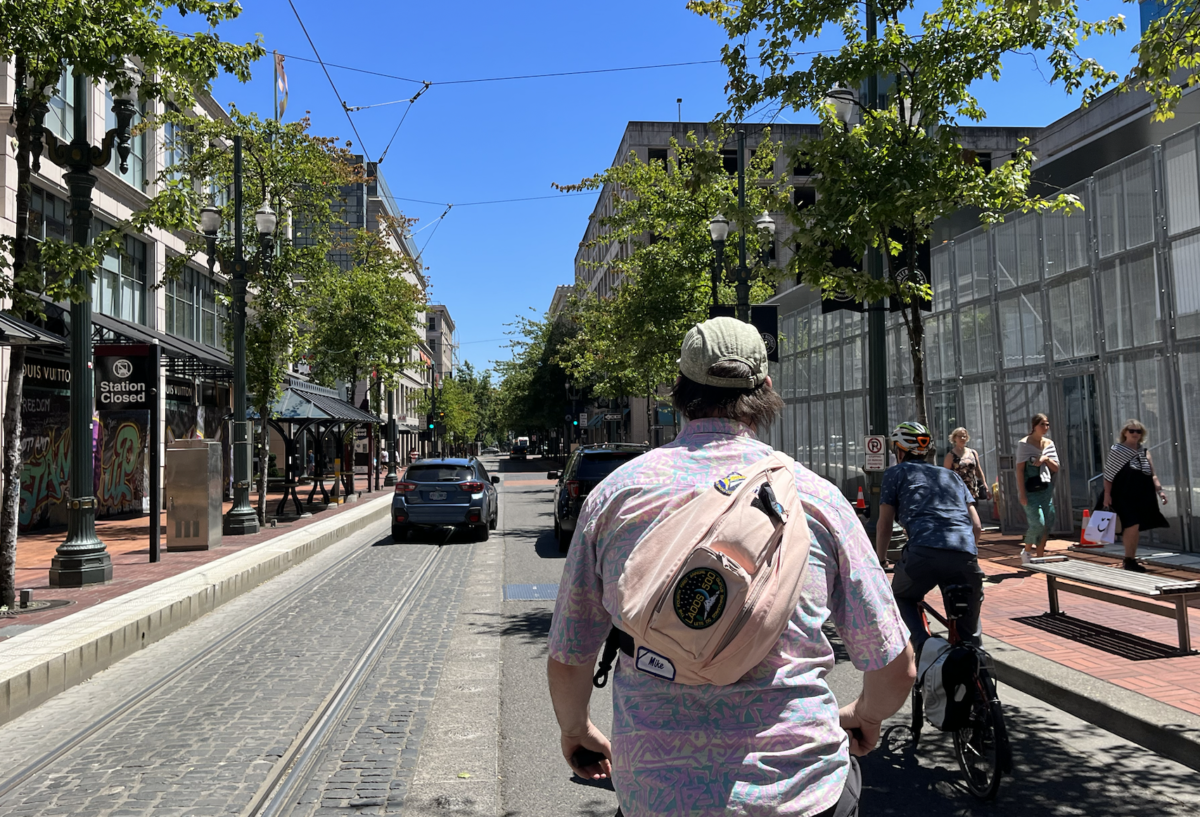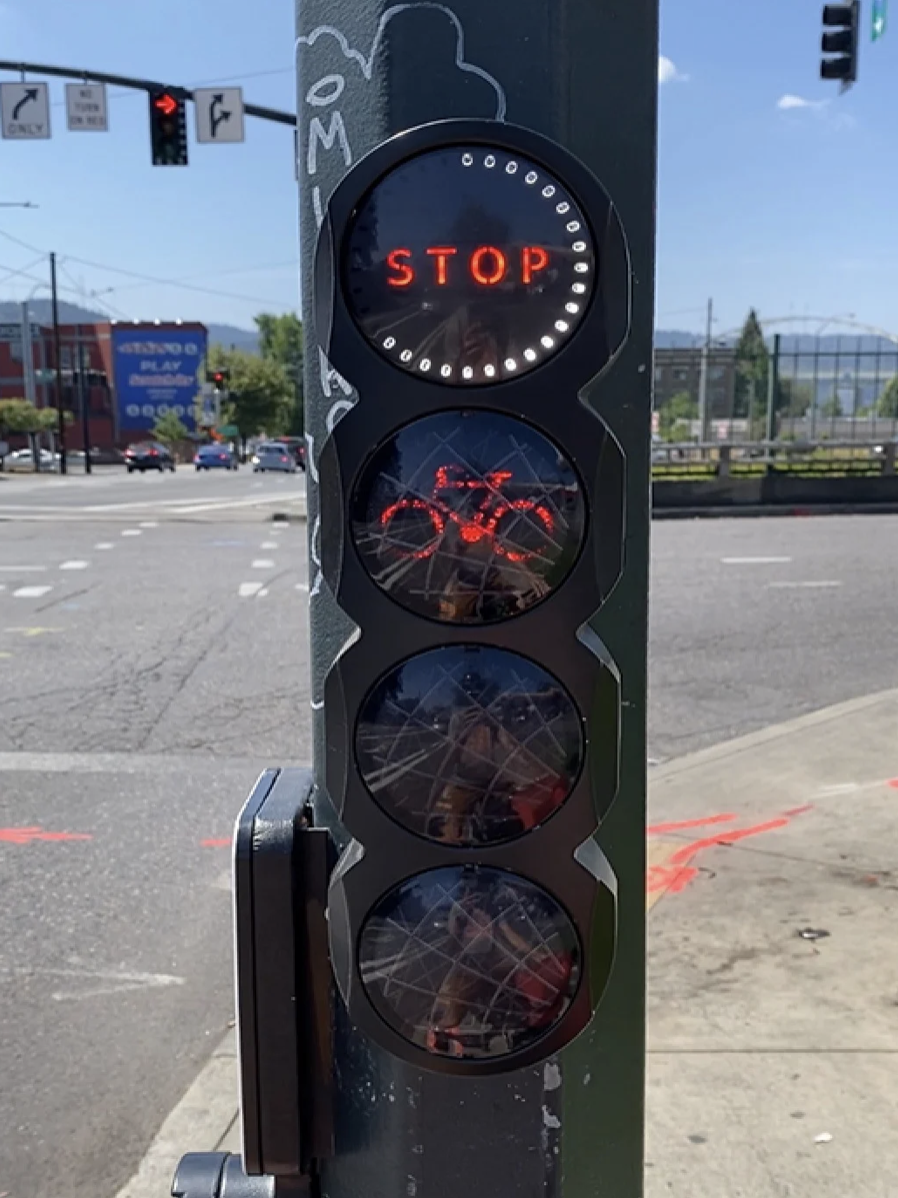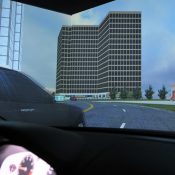

Good urban planning means the average person traveling around a city doesn’t need to know anything about what went into designing it – they can just get around intuitively. Peter Koonce, who manages the traffic signals and street lighting division at the Portland Bureau of Transportation, is keenly aware of this. Koonce and his team oversee signals many people use without much thought. But that’s okay with him, as long as they work.
On a ride last Thursday, Koonce led a group around Portland’s central city to talk shop about a few of the 1,200 traffic signals he manages. It was just the latest “policy ride” hosted by local bike advocacy group Bike Loud PDX that give the urban planning-curious a backstage look at what’s going on with projects around the city.
When it comes to signal operations, they’re much more complex than you think, especially when you take into account all the different transportation modes that need to function together. Koonce and his team at PBOT do take all these modes into consideration. And since private cars are at the bottom of Portland’s transportation hierarchy, PBOT always has an eye toward using signals to improve safety and be easy for non-drivers to use.
One way PBOT uses traffic signals to make it safer to walk and bike is to install a lot of them.
“We actually manage the speeds of traffic by using the signals frequently,” Koonce said.
The more signals there are, the more traffic will have to stop, unless people are going a safe speed. Most signals in the central city are timed to reward users with a string of greens if they’re going about 11-12 mph. That happens to be an average cycling speed. It’s also fast enough to get around, but slow enough to prevent calamitous crashes.

While some of Portland’s traditional signals are programmed with bicycle riders in mind, there are also bike-only signals installed specifically for them.
Koonce talked about a particular kind of bike signal they’ve imported from the Netherlands. It lets people on bikes know their presence has been registered and then offers a countdown so they know how long they’ll have to stop. In the gallery below, you can see a new signal on Naito Parkway on the left and a close-up of a similar signal installed on Broadway at North Williams Ave in 2020.


Using imported bike signals is not normal for American traffic engineers. PBOT’s Koonce happens to be an exception to the rule. He’s also a national expert who travels the country sharing insights about what we do here in Portland. His motive for encouraging other cities to try bike-friendly signal treatments, he said at the ride, is a roundabout way of influencing national signal standards (something he also gets to do in a direct way as an executive board member of the National Committee on Uniform Traffic Control Devices, a Federal Highway Administration advisory body).
“When Portland does something that’s new and innovative, [the FHWA, who authorizes new treatments] will say, ‘oh, that’s just Portland. That’s not in New York. That’s not LA. It’s not Boston. It’s just Portland,'” Koonce said. “So we’re hoping other cities will actually use them so it’ll become a more of a de facto standard.”
Koonce is known to push the envelope with what the (traditionally very conservative) FHWA allows, so he and his team have to carry out federally-mandated experiments when implementing signals like the ones used on Naito. They monitor data and usage patterns for the new signals, then report back to the feds. Recently, OSU and PBOT have partnered to analyze the Better Naito Forever bikeway and upcoming SW 4th Avenue Improvement Project to evaluate “bicycle safety and comfort, especially with respect to conflicts between turning vehicles, buses, and bicyclists at signalized intersections.”
The Bike Loud group looked at several different signal types on the ride. The one I found most compelling was on the new Naito Parkway protected bikeway at the intersection with Morrison Street. At this crossing, walkers need to cross the bike traffic lanes to get to the pedestrian beg button, which is on a concrete median island between the lanes (see image below).
While we were there, two passersby became unwitting participants for us to observe. Koonce pointed out they were good subjects because they did what PBOT doesn’t want people to do at that intersection: After crossing the bikeway to press the beg button on the island, they moved back to the curb they started on to wait for the signal (so they ended up crossing the bike path three times instead of just once).
“They’re walking out, not feeling comfortable waiting out there and walking back,” Koonce said. “We were actually worried [people would do that.]”
This was an important scene to witness because it demonstrates one of the most vital parts of Koonce’s job: to understand human behavior. Good signal design shouldn’t force people to do things that aren’t natural based on the transportation bureau’s agenda. That can lead to low compliance and dangerous outcomes. Koonce instead aims to constantly tweak the system so it achieves the city’s goals while also being intuitive. And he’s a sponge for data, always asking for more input.
“We’re ironing out those kinks, and so continue to give us feedback as you experience Better Naito,” Koonce said. “We’re always debating: Is this really going to work for people? How do we communicate to people? And how do we make things better?”








Thanks for reading.
BikePortland has served this community with independent community journalism since 2005. We rely on subscriptions from readers like you to survive. Your financial support is vital in keeping this valuable resource alive and well.
Please subscribe today to strengthen and expand our work.
I love reading about stuff like this! Thanks for writing it up. 🙂
Most of the induction loop bike detectors on my commute don’t work so I either have the option of awkwardly hopping up on the sidewalk and hitting the beg button or running the red. I obviously choose to run the red (which is now ambiguously legal when the signal does not work for people biking).
They’ve started implementing timed signals on 82nd and cross streets that were previously set off by buttons or loops. Not sure if it’s during rush hour but it does slow down that early morning traffic. That being said the fact that they can’t set the timing between lights on greenways to be consistent or for cycling speeds sure does get me to run more reds. Especially early in the morning when there’s almost no one around.
When you stop to turn from the Naito bikeway onto one of the westbound streets are we supposed to lean over and press the pedestrian beg button or is there an induction or optical sensor situated to detect us in the little median strip? I’ve just been pressing the beg button. (Actually, I usually press the beg button, get impatient, and cross on red because the whole area is still pretty deserted.) If there is a sensor, is the timer logic different from the pedestrian beg button?
Personally, if I’m on my bike I refuse to push pedestrian crossing buttons. I know how to line up with an unmarked detector loop to trigger a signal but if there is no loop or it’s not working, I’m never shy about going when it’s safe regardless of the signal color.
“They’re walking out, not feeling comfortable waiting out there and walking back,” Koonce said. “We were actually worried [people would do that.]”
Will they fix this?
Of course people are going to wait in the shade & and a place where everything is in front of them..and not in place where car are in front and bikes are passing behind them…
so they were worried about it, but did nothing to address or fix it..just built it bad, and let everything deal with it..thanks again PDOT..
Glenn F, a little situational awareness might help you relax. You folks in Ptown have it better than literally any other large or small city in this country.
We are literally the crash test dummies for the rest of the USA bike riding communities. I don’t think this is better. Nor do I think Portland bikers and walkers are a good cross section example of the ‘regular USA’ sample size.
The traffic policy wonks love this stuff, but regular riders who encounter different intersection types, repeated daily, are frustrated with some signals that work, some that don’t. I don’t understand how national trends can be deducted from these local intersection improvements with a local populous that is far from ‘normal’.
I don’t like it one bit being the crash test dummies for national policy recommendations. Peter Koontz gets a lot of professional accolades but some of us aren’t fans of being tested on.
Sort of like WOC and birth control testing or any other unethical medical testing on POC. Same for PDX bikers.
If we really wanted to focus on Bike Safety we would do a better job at tracking biking and walking safety incidents/data and addressing the lack of data and flagging this up the chain as a NATIONAL PRIORITY. We don’t have good national bike/walking safety data and no amount of traffic light engineering will address that. #notgoodenough
Agreed re: national priority/approach. Unfortunately that just isn’t our reality. Perhaps your city IS ‘flagging it up the chain’ through the only channel that exists IRL for influencing national transport policy and engineering standards. I don’t mean to judge that you find it frustrating to cycle in Portland, and I don’t live there so I’ll show myself out while I’m at it, but I do have to wonder if you have tried cycling in any other busy US city with limited or zero bike accomodation. Frustrated beats maimed or deceased … be safe out there everyone.
I somehow don’t believe that.
I’ve noticed that some traffic signals will change to green before a MAX train has finished passing by. Seen this in Lloyd Center and downtown areas. Assuming that Peter and crew are aware of these apparent mis-timings, then why?
The opposite happens all the time of course. There should be a three second rule: if the train is physically clear for three seconds but the signal is still red, the signal needs to be redesigned. All the unnecessary waiting is ridiculous.
Maybe this is better aimed at koonce’s inbox, but why are the signals for better naito to cross the steel and Hawthorne bridges so dumb? Both have car traffic volumes tied completely to other signals up and downstream, yet seem to be on their own, fairly standard cycle. The one to cross the steel bridge onramp is red most of the time for bikes, despite only allowing traffic from one lane which is receiving cars in only half the phases of another light a block away, leading to a green for nobody much of the time. The one to cross the Hawthorne onramp is on it’s own cycle despite the fact there’s another signal once cars get up to the bridge, so they go through, blocking bikes, and then must stop anyways. Not to mention it also defaults to green for cars most or all of the time. It would be crazy to suggest that lights at a highway junction must detect cars before they can start to change the lights to let them through, but here we are on the latest and best bike route in the city…
Great article. Has the PBOT considered putting QR codes that link to feedback forms on some of this infrastructure so that folks can provide direct feedback on infrastructure (e.g. pedestrian crossings) as they encounter/use it?